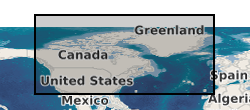Glaciation
Type of resources
Available actions
Topics
Keywords
Contact for the resource
Provided by
Years
Formats
Representation types
Update frequencies
-

The El Nino-Southern Oscillation (ENSO) is the most potent source of interannual climate variability. Uncertainty surrounding the impact of greenhouse warming on ENSO strength and frequency has stimulated efforts to develop a better understanding of the sensitivity of ENSO to climate change. Here we use annually banded corals from Papua New Guinea to show that ENSO has existed for the past 130,000 years, operating even during "glacial" times of substantially reduced regional and global temperature and changed solar forcing. However, we also find that during the 20th century ENSO has been strong compared with ENSO of previous cool (glacial) and warm (interglacial) times. The observed pattern of change in amplitude may be due to the combined effects of ENSO dampening during cool glacial conditions and ENSO forcing by precessional orbital variations
-

Numerical model predictions of present-day horizontal deformation due to ongoing glacial isostatic adjustment processes at GPS sites across Antarctica. Model accounts for 3D spatial variations in Earth rheology using a finite element approach.
-

Data generated using freely-available satellite remote sensing observations from the USGS Earth Resources Observation Science Centre, together with a freely-available ice margin chronology from Dyke et al. (2003) Geological Survey of Canada Open File Report No. 1574. The map is published in the Journal of Maps: http://www.tandfonline.com/doi/full/10.1080/17445647.2014.912036 Published article in 'Nature' Volume 530 Feb 2016 with associated source data. https://dx.doi.org/10.1038/nature16947 Published paper in the Taylor Francis Online Journal with associated data. https://dx.doi.org/10.1080/17445647.2014.912036
-

This image dataset was captured as part of the operation of an automated weather station at the Virkisjökull-Falljökull Glacier, SE Iceland. The station formed part of the BGS Iceland Glacier Observatory network of sensors, deployed between 2009 and 2020 in order to characterise and identify glacial, geomorphological and hydrological drivers and processes and their timescales across the deglaciating Virkisjökull-Falljökull catchment in SE Iceland. This image time series was captured at (WGS-84) 63°58’12.78?N 16°47’5.64?W, on a lateral moraine sequence adjacent to the glacier icefall and were generated alongside the continuous operation of two further weather stations, river gauging, a network of groundwater level gauges and numerous other forms of monitoring. The records presented here begin in September 2011 with the installation of the camera on the weather station, and continue to February 2018. The data complements the published groundwater and river gauging datasets published here, and will be of use to researchers, teachers and students wishing to see an excellent example of glacier flow, or those interested in the processes observed in a rapidly deglaciating landscape, including anyone interested to follow up on the various research studies published from this site in the international literature. The BGS project was led and coordinated by Dr Jez Everest, and during earlier years Tom Bradwell (Uni of Stirling, formerly BGS). Technical support and implementation was provided by Heiko Buxel and Tom Shanahan. The dataset is not fully continuous as certain periods were lost due to equipment downtime. Enquiries are welcome and should be directed to Dr Everest.
-

This image dataset was captured as part of the operation of an automated weather station at the Virkisjökull-Falljökull Glacier, SE Iceland. The station formed part of the BGS Iceland Glacier Observatory network of sensors, deployed between 2009 and 2020 in order to characterise and identify glacial, geomorphological and hydrological drivers and processes and their timescales across the deglaciating Virkisjökull-Falljökull catchment in SE Iceland. This image time series was generated alongside the continuous operation of two further weather stations, river gauging, a network of groundwater level gauges and numerous other forms of monitoring. The records presented here begin in September 2011 with the installation of the camera on the weather station, and continue to December 2019. The data complements the published groundwater and river gauging datasets published here, and will be of use to researchers, teachers and students wishing to see an excellent example of glacier flow, or those interested in the processes observed in a rapidly deglaciating landscape, including anyone interested to follow up on the various research studies published from this site in the international literature. The BGS project was led and coordinated by Dr Jez Everest, and during earlier years Tom Bradwell (Uni of Stirling, formerly BGS). Technical support and implementation was provided by Heiko Buxel and Tom Shanahan. The dataset is not fully continuous as certain periods were lost due to equipment downtime. Enquiries are welcome and should be directed to Dr Everest.
-

Antarctica and its ice sheets have played, and continue to play, a major role in the global ocean-atmosphere system, hence, it is critical that we have a sound understanding of the past behaviour of Antarctica and it's ice sheets with a view to understanding their potential future variability under a warming climate. The Southern Ocean is a key component of the thermohaline circulation of the world's oceans and the re-distribution of heat and salt around the oceans is integral to processes that regulate rapid climate transitions. Computer modelling results have shown that sufficient melt water input to the Antarctic continental shelf area is capable of shutting down the formation of cold, salty deep water in Antarctica hence upsetting the balance of the thermohaline circulation and the ocean-climate system of the Northern Hemisphere. In order to further investigate these processes that originate in Antarctica, it is necessary to understand the transfer mechanisms of ocean-climate signals from the Antarctic ice sheets, across the continental margin seas, into the Southern Ocean. Exceptionally well-preserved Antarctic margin sediment cores, recovered during the last decade, contain an excellent archive of these ice-ocean-climate interactions, often on seasonal timescales, from the end of the last ice age and throughout the recent warm interglacial (the Holocene). The cores are seasonally layered through the deglaication, intermittently layered through the Holocene, and the layers are dominated by fossil planktonic diatoms (algae); individual species of which are sensitive to sea surface conditions including sea ice concentration, fresh water influx, and open ocean influence upon the margin. Following the last ice age, these Holocene Antarctic sediments record climate fluctuations of tens to thousands of years long and whatever environmental forcing mechanism is responsible for these fluctuations, the changes are likely to be felt in the Antarctic coastal regions first, and the cores proposed for this research are located in prime positions to record these changes. Diatom oxygen isotope measurements represent an under-utilised technique that provides a means of obtaining oxygen isotope records in high latitude environments. The measurement of oxygen isotopes in diatoms is a widely used proxy in the study of the history of lakes, however, to date there have been many fewer attempts to use records of diatom oxygen isotopes in the oceans. Studies that have taken place have demonstrated the sensitivity of diatom oxyegn isotope measurements in polar and sub-polar waters to changes in surface ocean environmental parameters such as salinity, freshwater input and sea surface temperature. The research proposed here will be the first attempt to produce diatom oxygen isotope records from the Antarctic margin, a region sensitive to the waxing and waning of the Antarctic ice sheets in terms of melt water through-put to the Southern Ocean. We propose to investigate the evolution of seasonality along the Antarctic margin since the last ice age, and also the processes involved in producing the sediment record, by relating diatom oxygen isotope measurements on season-specific diatom taxa (i.e. diatom species that thrived particularly in spring or autumn) to relative freshwater influx to the coast, from either melted terrestrial ice or sea ice. We also hope to show that the diatom oxygen isotope measurements will be low at the end of the last ice age, as a large quantity of old ice sheets were melting, and will be higher during warmer time periods of the Holocene when ice sheets were at a minimum.
 NERC Data Catalogue Service
NERC Data Catalogue Service